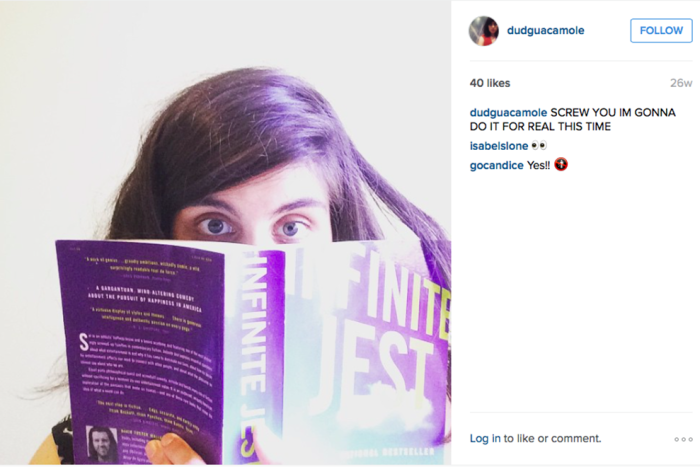What was important to us in 2015? Hazlitt’s writers reflect on the quiet reverberations of the year’s big issues, and the loud ring of its smaller ones.
Spend enough time around writers, musicians, or artists who live in a place that could be reasonably described as a city and the topic of conversation will inevitably turn to anxiety over housing. This isn’t all that shocking, really, for a plethora of reasons, from creeping gentrification to the rising appeal of urban living for the affluent to the fact that the city provides observers with wildly different ideological positions equal cause to find alarm in the current state of affairs. Some writers lament the erosion of a familiar community; some bands look elsewhere for cheaper practice spaces and area codes to call home.
Others address it more directly, working those concerns into their art—sometimes with earnestness, sometimes with humor. The third song on the Seattle punk band Childbirth’s album Women’s Rights, “Tech Bro,” deploys satire to wrangle with the issue: “Tech bro, tech bro/ Take me to your condo/ I’ll do my laundry while you code,” vocalist Julia Shapiro sings. Earlier this year in Vice, Zachary Lipez addressed the phenomenon of writers writing about leaving New York by declaring his immovability. “In 20 years,” he wrote, “find me on a rent-stabilized sandbar off the coast of the Rockaways.”
Some artists address this urban disquiet by looking to the past, making implicit the comparison between a time when a given city was more welcoming to artists than it currently is. In her essay “Manhattanville, Part Two,” contained in her excellent collection Multiply/Divide, Wendy S. Walters writes of the experience of watching a neighborhood change around you:
Buildings I have become accustomed to seeing every day have been dismantled, and streets have disappeared into a long, flat hole out of which the new campus will rise while I, like many other residents of Manhattanville, will be left standing at the outskirts of possibility.
Walters writes with pain and precision about her own experience. It’s one of a number of lives glimpsed over the course of the narratives in her book, which encompass essays and short stories, and delve into a series of historical avenues while chronicling an uncertain present. Walters offers one nonfictional way to encompass a series of changes in a city; another can be found in Luc Sante’s The Other Paris, which looks at numerous subcultures and communities in Paris over the course of the last few centuries. If there’s a villain in this book, it’s Georges-Eugène Haussmann, whose changes to the layout of Paris overran a number of the compellingly anarchic communities that Sante describes in meticulous detail.
From the early pages of The Other Paris, Sante is clear about the implicit contrasts in the narrative that he is telling here:
There are indeed a few places in Paris where the poor can live, but the requirement is that those places be inhuman, soulless, windswept. In the past the poor were left to hustle on their own, which might mean accommodating themselves in squalor, with accompanying vermin; the bargain they are offered today assures them of well-lit, dust-free environs with up-to-date fixture, but it relieves them of the ability to improvise, to carve out their own spaces, to conduct slap-up business in the public area if that is what they wish to do.
Walters and Sante offer nonfiction perspectives on the way cities can change, and the ways in which that change can appear to those present for it, or sifting through its histories. (In addition, earlier this year, memoirs by Robert Christgau and Kim Gordon offered two perspectives on the evolution of downtown New York from the 1970s on through the present day.) But the same anxieties and disparities that Walters and Sante so memorably chronicle have also provided the raw material for some of the year’s most compelling fiction.
*
The first sentence of Kathleen Alcott’s novel Infinite Home tells a story on its own: “The neighbors hadn’t noticed the building’s slow emptying, didn’t register the change until autumn’s lavish colors arrived and leaves sailed through the windows the man hadn’t bothered to shut.” The novel follows the residents of a Brooklyn apartment building, including Edith, the building’s kindhearted, elderly owner, who is slowly being overcome with dementia. All of the residents are somehow on the margins of society: a comedian whose heyday was decades before, a man with Williams Syndrome, and a woman struggling with agoraphobia. “She drank them in like tap water, unconcerned about their original source and the details of their travels to her,” Alcott writes.
Edith’s penchant for not raising rents makes the space something of an oasis for them, but her increasingly fragile health reveals it to be a temporary one. There is a slow-burning plot, involving Edith’s borderline-sociopathic son seeking control over the building and the residents looking for a way to avoid this. But Alcott’s meditative style focused on history and routine: this is a novel that evokes the space its title summons from the outset. And for all that its action is largely set in the gentrifying Brooklyn of the present day, one character’s late-novel trip also incorporates changes to San Francisco in recent years—a reference to “the exorbitantly priced hotel room” and a homeless woman’s laments about the city trying to push her out among them.
There’s a looming sense that a change is on the way in the city—one character is involved with a dubious development project, while another’s argument against a certain nihilistic strain in punk takes on a much broader context given the novel’s scope: “You can’t only tear shit down and assume that what springs up in its place is going to be better.”
Alcott’s novel is focused in its scope yet fluid in its storytelling, jumping from past to present as it unveils the lives, histories, and actions of its characters. Structurally speaking, Garth Risk Hallberg’s City on Fire is almost its opposite: sprawling, with a tendency to loop back on its own timeline to reveal motivations, secrets, or unexpected personal connections—to say nothing of the way that it also incorporates other means of storytelling, including a zine and excerpts from a manuscript-in-progress. (The two novels do share a sense that a city’s history is in constant flux; characters in both consciously recall how things used to be.) Hallberg’s approach is less nostalgic than one might imagine: although he’s understandably taken with the potentials inherent in the growing DIY scenes and the way that art and music took on new forms, he’s also aware of the dangers the city holds. Random acts of violence befall several characters; the fact that the novel’s climactic sequence takes place against the backdrop of the 1977 blackout also makes for an ominous set-piece. For the characters seeking a kind of resolution, they must do so against an increasingly chaotic backdrop, one in which hospital generators threaten to fail, vehicular catastrophes abound, and other safe—or at least familiar—landscapes turn hostile.
Several of the viewpoint characters in Hallberg’s novel hearken back to an older generation of New Yorkers—a detective investigating the crime around which much of the plot revolves, and a journalist whose project draws him into it as well. It makes for a welcome moment of perspective: these are characters whose sense of the city allows for the late Seventies to be placed into a context relative to the previous decades. And, in a handful of brief scenes, Hallberg also leaps into more recent history, adding a larger view to how these characters did or did not continue to make their way in the city, and how larger historical events affected them. There’s also room for some ironic touches, such as the following from one glimpse of where one character ended up a few decades later: “Anything Eighties, anything Downtown, had lately acquired a kind of millennial cachet—particularly among the people responsible for Downtown’s ruin.”
Much of Hallberg’s novel involves juxtapositions and contrasts as they relate to race, gender, sexuality, and economic status. Questions of power continue to be asked throughout the novel: for all that some of the book’s characters must reckon with their own privilege (or not), there’s also a looming sense that a change is on the way in the city—one character is involved with a dubious development project, while another’s argument against a certain nihilistic strain in punk takes on a much broader context given the novel’s scope: “You can’t only tear shit down and assume that what springs up in its place is going to be better.”
*
Not that every period depiction of New York makes it seem like an enviable place to live. Stacy Wakefield’s novel The Sunshine Crust Baking Factory follows a young woman, Sid, who arrives in New York in 1995 looking to squat in an abandoned building. By the time she arrives, she learns that this is no longer viable in Manhattan. (Readers seeking a fictional chronicle of that would do well to check out Cari Luna’s 2013 novel The Revolution of Every Day.) Instead, Sid crosses the East River for Williamsburg in the days when northern Brooklyn still abounded with abandoned industrial spaces that called out with possibility. Still, for all that certain characters, including her father, praise Sid for essentially beating the system, Wakefield’s narrative makes it clear that this isn’t a utopian way of life.
If you’ve ever witnessed the infighting that can take place within a punk scene, much of The Sunshine Crust Baking Factory will ring true: Sid soon falls in with a charismatic guitarist who spent time in an acclaimed band and who turns out to be a less-than-admirable figure. The details of living in spaces without plumbing or power—including a reference to the “piss bucket” used in one squat—make for a visceral experience. One could look at Wakefield’s novel (and Luna’s before it) as a kind of counterweight to other books dealing with New York in bygone decades, works that also emphasize exactly why said bygone decades run the risk of being overly romanticized. One can read these novels and find oneself empathizing with the residents of the squat without necessarily wanting to forego a more traditional existence.
Yet another take on the New York of old can be found in Eileen Myles’s recently reissued novel Chelsea Girls, which was first published in 1994. Chronologically, it leaps around, covering Myles’s childhood with time in New York and (when the book opens) Portland. What makes reading Chelsea Girls particularly interesting is its lack of an overt context—it certainly evokes the New York of a specific time, but it does so without lionizing it, without going through the specific lens of memoir. At one point, when discussing a portrait of her taken by Robert Mapplethorpe, Myles makes a statement about the image that could well serve as a manifesto for this book. “It’s kind of scary,” she writes. “I don’t understand who she was at all. But that’s all right. It’s the past.”
Cities change, and the way that writers write about them changes as well. A place's past can act as a kind of call to arms, or it can become the backdrop for a different kind of story. That anxiety is nothing new: the community in Alcott’s Infinite Home reads, at times, like a descendent of the eccentrics that populate John Steinbeck’s Cannery Row and Sweet Thursday. Finding the echoes of a community—their triumphs and their anxieties and, sometimes, their downfall—is the stuff from which compelling literature can be made, even when it comes filtered through heartache.






